First of the two part memoirs of an extraordinary woman and mother
Connecting with the Past
On a cold January morning in 1946 in New Delhi, India, Ranee awoke early, with a sense of excitement mingled with trepidation. Today was the day when she would be secretly travelling all by herself, to attend the Indian National Army trials in Red Fort1. She had confided in no one about her plan, not even in her mother or in Mejda, as she called her eldest brother Guni, who was fourteen years her senior, and was almost like a father- figure to her. She was strongly influenced by the Indian struggle for freedom against British rule, and was especially passionate about the contribution of Netaji Subhash Chandra Bose and the Indian National Army to the freedom movement. Born on 3rd April, 1932 in New Delhi, now almost fourteen, Ranee was fiercely patriotic. The song written by Netaji, kadam kadam barhaye ja2 was her favourite, and she used to sing it effortlessly in her untrained but powerful, musical voice. She had been following newspaper reports on the INA trials avidly since they started in November 1945 and she longed to witness the trials first hand, at least for a day.
Ranee got ready quickly and put on her school uniform. As she tied her long, black, wavy hair into two thick plaits, she thought of how Shomu, her youngest and most mischievous brother who was only a little older to her, had snipped off one of her long plaits while she slept on her bed one afternoon, not very long ago. She remembered how she had wept inconsolably on awaking to discover this unforgivable prank, and how Shomu had laughed gleefully, when her mother, scolding him, was compelled to cut off the other plait as well. Collecting her thoughts, Ranee examined her plaits in the mirror, glad that her hair had grown fast, and was almost back to its former length.
Her mother, Shibarani Devi, up since dawn, had already completed her elaborate Puja, and was busy in the kitchen. As Ranee came in, she looked disapprovingly at her youngest daughter’s school uniform of skirt and blouse, wishing for the umpteenth time that the school had allowed her to wear sarees, as her other daughters had worn in their schools. But her eldest son, Guni had wanted Ranee to go to an English medium school – and now here she was – dressed like a memsahib! Shibarani had been only thirteen when her eldest son Guni was born, and now an adult, he often refused to listen to his young mother’s objections, especially when it concerned his little sister Ranee, who was the apple of his eye. Her lips set in a firm line of disapproval, her small, fair face turning pink with unspoken annoyance at Guni’s obstinacy, Shibarani silently gave her daughter a simple breakfast of roti and dal which Ranee loved.
“Don’t play pittoo(7 tiles) with the boys as you usually do after school, Ranee,” cautioned her mother, as her beloved young daughter, tall and graceful, was about to leave. “It’s a boys’ game, after all… don’t be such a tomboy! You have such a wonderful, melodious voice. Why don’t you learn singing at home like your other sisters? Their tutor will be coming this evening to teach them. Come back straight from school and join them!”
“But I love to play pittoo, it’s such an exciting game! I wonder why none of the girls play,” replied Ranee, laughing out loud at her mother’s words, while her eyes shone with mischief. She opened the gate of their rented house on Todar Mal Lane, let herself out, then turned and reassured her mother. “Don’t worry, Ma, I won’t go to play pittoo today!” Ranee knew that she would not be missed till late afternoon, as her family would expect her to have gone to school.
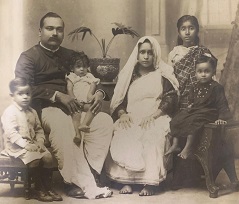
As she travelled by bus to Red Fort, she thought longingly of her late father, Raisaheb Sindhulal Bhattacharya, whom she hardly remembered, wishing that he had been there with her, for she would have surely confided in him… perhaps he would have accompanied her to the Red Fort today! If only he were alive… her thoughts wandered and her vivid imagination conjured up that fateful morning in 1936, when his sudden and untimely death changed the destiny of her large family completely. Not yet four years old, and the youngest of ten children, Ranee had hardly any memory of her late father, except one shadowy image of herself, running to him to climb on to his lap, tripping and falling down; her father, a tall, fair, well- built man with a moustache, clad in a white dhoti and coat, quickly coming and picking her up, consoling and petting her. That was all. Her knowledge about him was what she had gathered from her mother, and her older siblings, who had far more vivid memories of him.
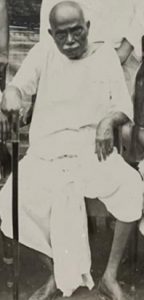
Ranee had heard that she came from an academically distinguished Nyayaratna family, and excellence in academics marked the careers of her father and paternal grand-father, Shri Motilal Bhattacharya and her great grandfather, Shri Dinanath, the latter being conferred the title ‘Nyayaratna’ for his command over Nyay stream of Philosophy3. Shri Dinanath was appointed the Professor of Sanskrit in Sanskrit College, set up in Calcutta by Lord Amherst in 1824. After retirement, he returned to his native village of Harinavi and taught Sanskrit literature, grammar and philosophy to local students for free; he also provided financial assistance to needy students. When the Headmaster of Harinavi A.S. School suddenly resigned, Dinanath officiated as the Headmaster for some time. Ranee knew that the street on which their ancestral home stood, was renamed ‘Dinanath Nyayratna Street,’ and she hoped to visit the place, some day.
Ranee’s grandfather and Shri Dinanath’s son, Shri Motilal had also been a renowned Sanskrit scholar, who was conferred the titles of Vidyaratna, Mahamahopadhyay and Upadhyaytilak4 at different stages of his scholarly career. He had topped the M.A. Sanskrit Examinations of Calcutta University, and had later passed his M.A. in English from the same University. He was appointed Head Professor of Sanskrit in Albert College founded in 1862 by Keshab Chandra Sen, the revered Brahmo Samaj leader. Later he travelled to Agra and became Professor of Sanskrit at Agra College, and was an examiner of Sanskrit in the Universities of Calcutta and Allahabad. Considered an authority in Vedanta philosophy, he was known to have been especially conversant in Adi Shankaracharya’s5 contribution on the subject.
Ranee, an avid reader, had already gone through a copy of his Lectures on Vedanta Philosophy which she had found at home, and she was filled with awe at her grandfather’s scholarship, though she could not fully grasp the meaning of much of what he wrote. She knew that the book, published and distributed in India and England by the Theosophical Society, was highly acclaimed. Consequently, the Maharana of Udaipur in Rajasthan, His Highness Shri Fateh Singh, had requested her grand-father to tutor his son Bhupal Singh in English, offering him double the usual salary. His efforts at tutoring Bhupal Singh were so successful that even Lord Curzon, the then Governor General of India was impressed by Bhupal Singh’s prowess in English. The Maharana was extremely happy at Shri Bhattacharya’s success as a tutor for his son and appointed him Director of Public Instruction of the state of Udaipur. Shri Motilal Bhattacharya served in this capacity for many years, before returning to his native state of Bengal. He was the author of many other books on Philosophy such as Nutan Pranali O Tattwa Samalochana(New Methods of Criticism of Theories) , Satyasangbad(True Knowledge) , and Utkrishtotar Tatwanirnoy(Theories of Superlatives), and Ranee had read much of these as well. Love for his native village, Harinavi, made her grandfather write Harinavir Purbakatha. He was associated with charitable organisations, and used to donate a large part of his salary to the masses of Udaipur. He passed away in Harinavi in 1933 at the age of 80.
As her journey to the Red Fort continued, Ranee’s thoughts travelled to her late father Raisaheb Sindhulal Bhattacharya. The third of five sons, he was born in Harinavi in 1886, and later graduated in Science and Arts from the University of Allahabad. Initially working as a teacher in Kanauj, he soon joined as a Superintendent in the office of the Accountant General in Rangoon, Burma. Ranee knew that before leaving for Burma, her father had married her mother, Shibarani, who was then only about ten years old – his second marriage. Ranee loved to listen to her mother’s stories about her parents’ life in Rangoon(present Yangon), and how Sindhulal loved to eat elephant-meat which she cooked for her husband in the evenings, while he enjoyed his port wine! Sindhulal was later transferred to Delhi and became a Gazetted officer in 1925. He was a prominent Bengali figure there, well- loved and respected, and was associated with many educational and charitable organisations, chief among which were New Delhi Bengalee Relief Fund, Raisina Bengalee High School (at present Raisina Bengali Senior Secondary School), Bengalee Club and the Bengalee Literary society.
In 1933, the British Government conferred on him the title of Raisaheb(honorific title conferred by the British state upon its talented subjects) and in 1934, he became the Assistant Accountant General in the Central Revenues Department, the first Indian to hold this post, the Accountant General always being British. Like his father, he was a scholar, and wrote reference books in Physics and Chemistry. He died suddenly of a vascular disorder at the age of 50, in his office at his official residence in Queen Mary’s Avenue, (presently Pt. Pant Marg near the Central Secretariat) New Delhi, on the 4th of January, 1936.
Ranee was jerked back to the present when the bus came to a halt before Red Fort. Her destination had arrived! Her heart thudding with excitement, she alighted carefully from the bus and joined many others who had come to watch the trial. Entering the ramparts of the ancient Fort, she felt a strange sense of calm replacing the trepidation she had felt when she awoke that morning. She knew that this had been the right thing to do, this was her small contribution to the Indian freedom movement. She was glad that she had followed her heart’s desire to come and express her support for the brave INA soldiers being tried by the British Government. Inside, as the trial unfolded before her awestruck eyes, she listened spellbound to the defence of the famous Indian lawyer, Kailash Nath Katju and was impressed by his confidence and oratorical skills.
Ranee returned home that afternoon much later than usual, to find her eldest brother Guni, pacing worriedly on the street before their small, rented house near Bengali Market where they had shifted after Raisaheb’s death. Her mother was sitting on a wooden stool just within the house gate, looking equally worried.
“Where have you been?” her brother demanded, looking closely at her fair, flushed face. “I don’t think you went to school – you are generally back home much earlier, even when you stop over to play pittoo with your friends. Tell me, where did you go?”
Ranee’s heart sank. Indeed, she had lost track of time in the Red Fort and felt guilty at having caused her mother and brother so much worry. Truthful by nature, she hesitantly said that she had gone to attend the trial of the INA soldiers in the Red Fort, but had not told anyone at home for fear of being reprimanded and prevented from going.
“You should have told me, Ranee,” said Guni reproachfully, “I would have taken you myself! As Indians, we are proud of our INA soldiers, and attending the trial is no crime. We shall go to the Red Fort together tomorrow.”
Ranee was amazed and delighted to hear her usually reticent brother saying this, for he had joined the 1942 Viceroy’s Commission, Corps of Signals, and always seemed to her to be busy and slightly aloof. She would later realise that the reason for his aloofness was actually his constant worry about his widowed mother and younger siblings, for, being the eldest son, he had been, for many years now, the only earning member of their family after their father’s unexpected and early death. Later, Guni or Gunindralal would be the only Indian Officer with the XIV Army of the Allied Forces, building Lido Road to Burma under Field Marshall Slim.
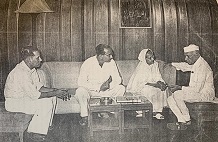
After India became independent, he would gain renown and distinction in the Indian Army as Lt. Col. G. L. Bhattacharya, and would be the pride of their family and of the nation. In 1961, on deputation from the Indian Army to the Subsidiary Intelligence Bureau (SIB), Calcutta, he would be ambushed and kidnapped on Indian territory by the Pakistani Army, wrongly convicted on charges of espionage by a special Pakistani Military Court, and sentenced to eight years of rigorous imprisonment in Dacca (Dhaka) Central Jail, East Pakistan. In prison, he would study military law code on his own (common to India and Pakistan, carried over from British days) and he would brilliantly argue his own case, while the Government of India would send the renowned barrister, Sri Siddhartha Shankar Ray, to represent him as well. Subsequently, his sentence would be reduced to four years and he would be released in 1964. Ranee, then living in Calcutta, would convey this heartening news to members of her family, including her sister Sneho in Allahabad, via telegram.
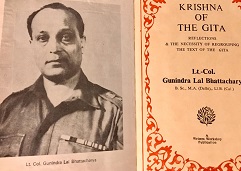
Ranee went to bed that night, filled with a sense of contentment, and the next day she happily accompanied her brother to the Red Fort to witness the on-going trial of the INA soldiers. The seed of a fiercely patriotic spirit was thus embedded in Ranee’s heart from an early age. It was no wonder then, that on 15th August, 1947 midnight, when India became independent, she rode on the back of a truck with friends and family throughout the night, excitedly waving the Indian national flag and celebrating along with thousands of fellow Indians, who were euphorically thronging the streets of New Delhi.
Ranee had been enrolled as Sati Bhattacharya, her official name, in Lady Irwin School, one of the foremost schools of New Delhi, situated on 12, Jaswant Road, opposite Pataudi House. Miss Suprabhat Chatterjee, a teacher in that school and engaged to be married to Gunindralal(who was then away serving in World War II), helped in admitting her there as he had requested. Ranee was an outstanding student, not only good in science subjects, but also in literature. She loved to read Bengali poetry and classics by Rabindra Nath Tagore, Bankim Chandra and Sarat Chandra, as well as English classics and contemporary bestsellers. The novels of Daphne du Maurier and A.J.Cronin were her special favourites, as were the detective stories of Agatha Christie. She spoke Bengali, Hindi and English fluently, had a literary flair and could write poetry and prose spontaneously and lucidly. Once, asked to write an essay in school, she mischievously submitted her copy writing only two lines:
“I’m thinking, thinking what to write,
My pen rebels and wants to fight!”
Her teacher, amused by her fearlessness and wit, did not scold her star pupil for not writing the essay but instead read out the lyric to the class in appreciation!
Much to her disappointment, Ranee could not pursue her desire of becoming a doctor due to financial constraints, and being fiercely independent, she did not want to be a burden on her brothers. Of them, Gunindralal, Brojendralal and Sachindralal had joined the Army, Rabindralal had joined the Airforce, and her younger brothers, Amarendralal and Samarendralal (Shomu, who had once mischievously snipped off her plait) would later join the Metereological Department and the Department of Audit, Ministry of Industries, Government of India, respectively. Two of her elder sisters were already married, while her remaining elder sister Sneho, a brilliant student who ranked 4th in her Higher Secondary Examination from Indraprastha School, was the first daughter of the family to resist early marriage and step out of the home for higher education. Though keen to become a doctor and a paediatrician, Sneho was offered a scholarship from the College of Nursing, Government of India, when it was established in 1946, and decided to join the Nursing programme of the college. She would later work as Sister-Tutor in Durgapur Steel Plant Hospital for eighteen years.
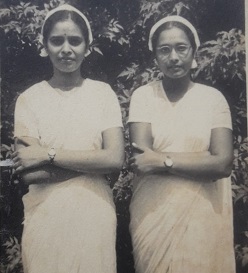
Ranee, like Sneho, enrolled in 1951 as a Nursing student in the same College of Nursing, later known as Raj Kumari Amrita Kaur College of Nursing, and obtained a scholarship to support herself as well. Optimistic by nature, she soon overcame her disappointment at not being able to become a doctor. She enthusiastically and diligently attended classes at Lady Hardinge Medical College, New Delhi on Microbiology, Anatomy and Physiology, taken by renowned doctors like Dr. Mahajan, Founder-Member of Ganga Ram Hospital and Registrar of the Surgical Unit of Irwin Hospital, Dr. Anand, the Director and Dr. Bhatia.
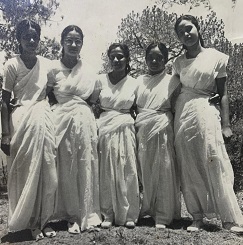
Ranee graduated in B.Sc (Nursing) in 1955 and due to her brilliant performance in the final examination, she became the first student to be immediately appointed as a teacher in the same college. Her students loved and respected their beloved Sati di, as they called her.
“Sati di mainly taught anatomy and physiology and always drew the anatomical diagrams deftly and with great skill, explaining her lessons with lucidity,” reminisces her former student, Basanti Majumdar, Ph.D, presently Professor Emeritus, Nursing and Department of Family Medicine at McMaster University, Hamilton, ON, Canada. “She was aware that her students were scared of her, for she was short-tempered and a hard task master, but she also loved and cared for us, and we used to wait for her rare smile of appreciation and approval.”
During her teaching career, Ranee, along with some of her colleagues, spent three months working at the primary health centre in Chhawla village, and loved primary health care and village life. She was liked by the staff at the health centre and the villagers too had a deep affection for her; she was greatly amused to learn that they referred to her as the lambiwali and safed (the tall and fair) teacher! Finally, in December 1958, she left New Delhi to settle down in Calcutta, West Bengal after her marriage.
To be continued
Dr. Ralla Guha Niyogi is an Associate Professor in the Department of English, Basanti Devi College, Kolkata
Footnotes
- Trial of officers of the British Indian Army who had defected to join the revolutionary Indian National Army. The trail was publicly held at the former Mughal Fort
- A popular song exhorting the youth to march forward
- Logic in Indian Philosophy
- titles earned by scholars of Sanskrit and Indian Philosophy
- 8th century Philosopher and Theologian
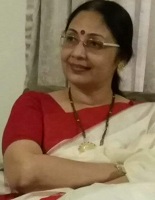
Itvis good to connect with you through my story, Mr. Debashish Bhattacharya. Much of the facts related to my mother’s ancestors have been obtained from the painstaking research work of my brother, Late Pronob Bhattacharya, ( son of Late Samarendralal Bhattacharya) and made available to me by my sister,Lipi Bhattacharya ( daughter of Late Samarendralal Bhattacharya) . I am indebted to both of them.
Thanks, everyone. Wonderful to connect with you, Mr. Debashish Bhattacharya. The Nyayrotno Bongsho talika was painstakingly prepared by my brother, Late Pronob Bhattacharya, son of Late Samarendralal Bhattacharya, and I am indebted to him. I am also grateful to my sister Lipi Bhattacharya for sharing these facts with me.
Thanks, everyone. Wonderful to connect with you, Mr. Debashish Bhattacharya. The Nyayrotno Bongsho talika was painstakingly prepared by my cousin brother, Late Pronob Bhattacharya, son of Late Samarendralal Bhattacharya, and I am indebted to him.
Namaskar.
I am Debashish Bhattacharya perhaps descendent of Late Sri Pareshlal Bhattacharya son of Late Shri Mihir Kumar Bhattacharya.
Amazing!
I was just going through a great piece of work Nyayratna-Bongsho talika by Shri Pramod Bhattacharya.
Thanks to Google that aids the ignited mind and here I am posting this message.
I am now settled in Greater Noida.
A line in acknowledgement would be highly appreciated.
regards
Very interesting! Particularly how both sisters were brilliant and insisted on a career. When one keeps hearing how “no women” worked in that era, such examples are so inspiring.
So well done. I loved the history. Learning about my teacher ( Satidi) made it more interesting to me.
Fascinating memoir so well written.